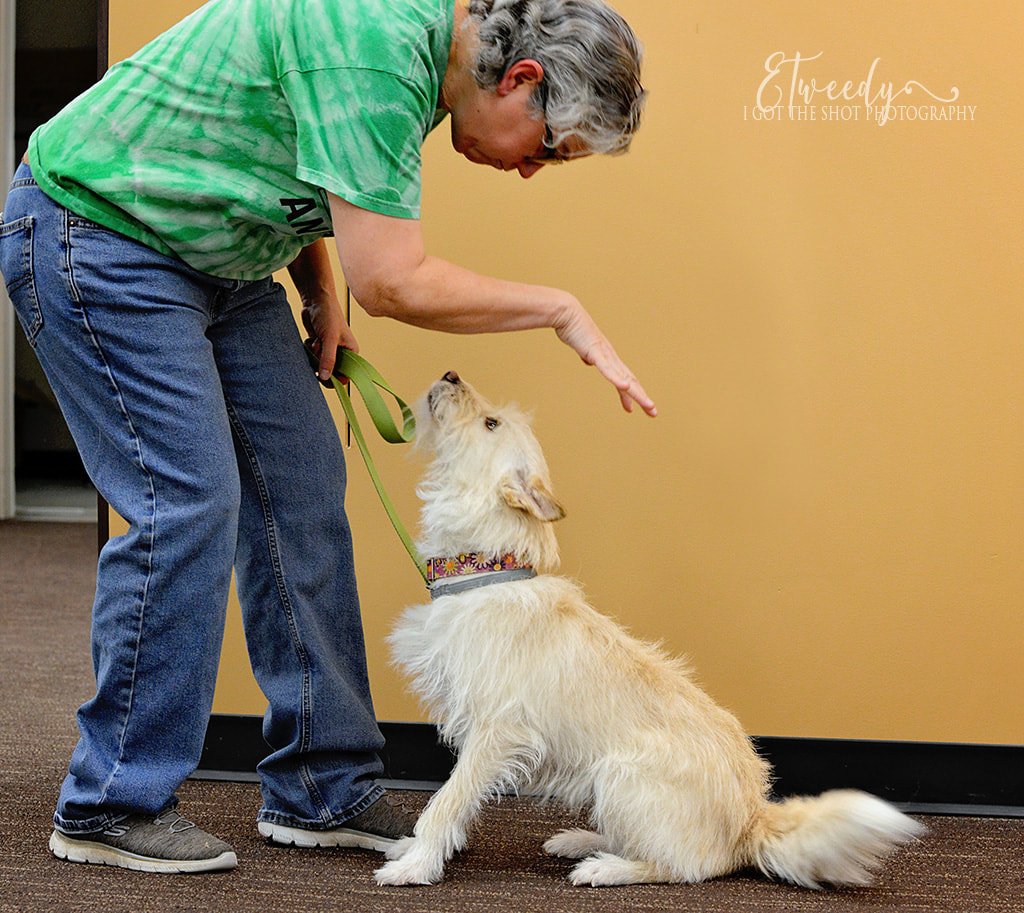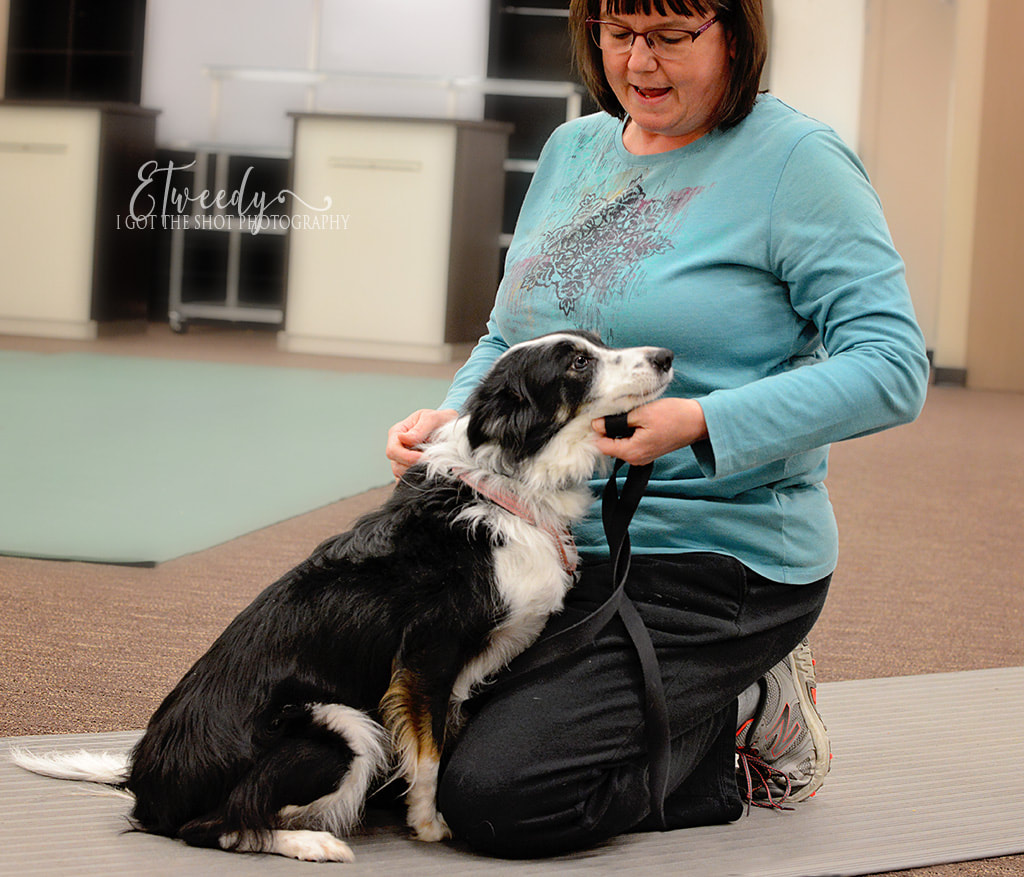I know I have.
My least favorite person to meet is "The Gusher." You know, the ooooher and aaaaher who speaks fluent babytalk. Honestly, I just want to turn around and run the other way, but my parents brought me up to respect all people, so mostly I try to educate. Nicely.
Because this is an important topic and I don't want you to just hear my complaints, I decided to get a little help from our dog Talley's training group, For Paws and a Tail, who walked me through what we should be mindful of, and what we need to avoid when greeting new dogs.
For Paws and a Tail - The Credentials
Mary Kettle and Chris Tresch focus on strengthening the human/canine bond, using approaches that run beyond traditional training classes. Their goal: seeing students and their dogs progress as a TEAM.
Classes offered range from basic through advanced obedience handling skills, using FUN and POSITIVITY as a guideline.
Their Obedience FUNdamentals Class attracted me immediately as an outlet for our deaf dog, Talley, to meet new people and socialize with other dogs. Mary describes this class as "where obedience skills are taught and advanced through the art of playing games." So far Talley and I have taken two sessions (beginner and intermediate), and we look forward to rejoining for a third session in March. FUN is absolutely the right word.
Together Mary and Chris have over 40 years of experience with the retraining of rescue dogs. Mary is just entering the competition world of Agility, Disc Dog and Flyball. Chris has competed in Agility & Flyball as well as in Rally and the obedience rings. Mary also has experience with Therapy Dog work.
This week, I visited their Winter training facility and they demonstrated their answer.
3 Best Greeting Practices
(1) Ask the Owner
ONE NEEDS TO ALWAYS ASK THE OWNER "MAY I PET YOUR DOG" before approaching a dog you don’t know. Remember to approach calmly, using a calm voice & relaxed posture.
AVOID: The “I love all puppies!” lunging toward the dog with an extended arm reaching over the top of the dog’s head approach.
NOTE: If the dog should appear to be shying away or pulling back away from you, then your approach was too strong. You can slow down your approach or may need to allow time for the dog to approach you. Just like people, dogs can respond differently to an unfamiliar person and/or different situations.
Remembering this phrase will remind you to approach calmly and not lunge toward the dog with an extended arm reaching over the top of the dog’s head. It will also act as a reminder that most dogs DO NOT like their heads pet by strangers.
Our dog Moe, didn't even like his head pet by US! So I can really relate to this phrase.
A friendly dog will accept the rub the chin, chest or shoulder approach much better than the proverbial "pat on the head."
And if you REALLY want to be successful, get yourself down to the dog's level. You are less threatening that way.
If you are good at doggy body language, you can read stress posture and overload behaviors. Common ones are wild eyes, yawning excessively, panting, whining, and ear movements. But there are others, and some dogs even invent their own.
It's why I cringe when I see those photos of kids on dogs, where the dogs are exhibiting at least 2 stress point behaviors and the owners are oblivious.
Remember the NOTE under item #1: When approaching a new/strange dog, if the dog should appear to be shying away or pulling back away from you, then your approach is too strong.
In the "ask the owner" photo above, you will notice Chris is giving both Mary and her dog, Mia, space. Mary is telling Chris that she may pet the dog, but to please wait until Mia is sitting. Mia is looking to Mary for instruction, and is not bothered by Chris, because Chris has not invaded her space. Small children really need to be taught this rule.
Final Thoughts
Whether I am working with a dog in studio or on location, I always let the dog decide when s/he is comfortable enough to interact with me. Sometimes, depending on the dog, I don't interact at all with them--I just let the owner interact. For some dogs, I am not only a stranger, but I am carrying strange black things that can be scary. I get it.
In studio, I will let a dog be off leash to smell everything they can. When they lay down on the floor for a break, I know they are ready to proceed. If I am a part of the sniff test, so be it. If not, that's okay too.
THANK YOU to For Paws and a Tail Training for participating in this week's blog. If you'd like to know more about them, and the classes offered, you can click on the link above (in the first series of paragraphs under the collage photos) which takes you to their Facebook page, or you can email: [email protected] or call/text 570-877-3086.
If you have a pet-related business and would like to collaborate on a blog post, contact me.
Click Into the Circle
I am part of a weekly blogging group of professional pet photographers located all over the planet. To see what others have blogged about in this week's topic "hi, how are you," start with New England Dog Photographer and former dog training instructor, Darlene Woodward, as she shares 5 top tips to successfully greet a new dog. Then find the link at the end of each blog to click to the next photographer.
Enjoy your weekend!







 RSS Feed
RSS Feed